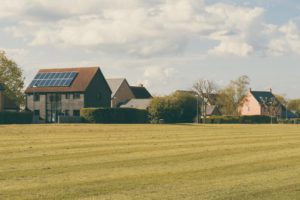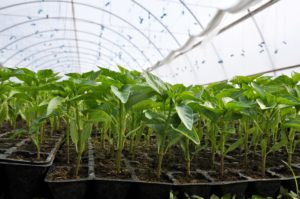Urban Homesteaders Driving Housing Markets – and Sustainability Initiatives
By: Guest Blogger, Erin Vaughan

Urban homesteaders are inspired by urban agriculture and driven to a sustainable lifestyle. They represent a small pocket of buyers whose aesthetic has slowly trickled out into the larger mainstream public, mirroring homebuyers’ growing interest in green homes and revitalization. Although urban farming has previously been blamed for lackluster markets and high housing costs, it’s much more likely that the opposite is true. In fact, agricultural projects on vacant and undesirable lands in the rust belt have served to both foster community and spur economic development.
The urban homesteading movement is not an official group, but an informal ethos shared by those homeowners who hope to reconnect to the land, energize flagging city properties, and support environmental projects through their homes. As such, it’s difficult to find precise statistics about how these homeowners’ actions are shaping (or are shaped by) current housing trends.
Still, the interests of homesteaders are compatible with those driving the housing market at large. Properties with green features, like renewable energy systems, energy-efficient features, and water-saving landscaping, tend to sell faster than their traditional counterparts. Meanwhile, when UCLA investigated whether labeling a home as “green” affects its worth, they found it raised the selling price by about nine percent. And some consumer research indicates that young homeowners are more interested in gardening and other outdoor projects than previous generations, so you can see how the interests of urban homesteaders are reflective of the homebuying population at large.

How to Integrate Urban Homesteading Ideas into Your Land
Given the trends shaping the market, it’s a smart move, both socially and financially, to look into the thought behind urban homesteading. Many of the projects are designed with a home’s energy-efficiency in mind, meaning homeowners continually save money by reducing or totally eliminating utility bills. But there are also deeper benefits in community engagement and environmental improvement that are difficult to quantify.
- Buy Cheap. One of the major themes amongst homesteaders is to purchase land cheaply to avoid massive debts—and to bring new life to undesirable properties. Vacant, foreclosed, bank-owned, or just unattractive or non-traditional properties and homes are favorites, since they can often be bought for cut-throat prices. You can then take the money you save and turn it around to use on improvements.
- Build It Yourself—Or Fix Up the Existing Site With Sustainable Improvements. DIY building, modular homes, and other structures are popular, since this allows property owners to get the features they want, like thermal walls and other passive heating and cooling techniques that cut back or even eliminate the need for HVAC, or highly-advanced rain capture systems, that allow them to recycle runoff for bathing. Purchase a property or a fixer upper to get in on the trend.
- Go Solar. Urban homesteaders overwhelmingly favor renewable installations, particularly off-grid systems, that allow them to generate their own energy, meaning they don’t have to rely on local power plants and grids for support. That fits right into the homesteader’s preference towards thrift, since many systems start paying for themselves in energy savings the day they’re installed.
- Invest in Ecological Improvements. While homesteaders are usually drawn to agricultural projects, they often use these projects as an opportunity to improve the land. For instance, aquaponic farming, which ironically has a much smaller water footprint, is a common technique, allowing homeowners to sustainably grow vegetables and other produce while farming fresh fish. Even a small edible garden will help you improve the land while generating fresh, pesticide-free produce.
- Build a Community. At the heart of the movement is community—homesteaders often donate or sell excess edibles back to local residents to help them secure access to fresh food, or participate in improvement projects in the area to revitalize the community at large. And they pass on what they’ve learned, teaching area children and interested adults how to be more self-sufficient.
Of course, your agricultural dreams can’t become a reality without first locating a piece of land. Best of luck building your own little homestead in the urban jungle!
About the Writer
Erin Vaughan is a blogger, gardener and aspiring homeowner. She currently resides in Austin, TX where she writes full time for Modernize.com, with the goal of empowering homeowners with the expert guidance and educational tools they need to take on big home projects with confidence.
Buying and selling ranch land is a complex experience. When you add in more acreage and a custom, luxury home, that experience can be even more difficult. That’s why United
Every week we share a story with you from someone who’s found their freedom with United Country. From buyers to sellers, from brokers to managers – everyone in the United
Recent Posts
Archives
- May 2020
- April 2020
- March 2020
- February 2020
- November 2019
- September 2019
- August 2019
- April 2019
- March 2019
- January 2019
- November 2018
- October 2018
- September 2018
- August 2018
- April 2018
- January 2018
- September 2017
- August 2017
- June 2017
- April 2017
- March 2017
- January 2017
- December 2016
- November 2016
- October 2016
- September 2016
- July 2016
- June 2016
- May 2016
- April 2016
- March 2016
- December 2015
- November 2015
- October 2015
- September 2015
- August 2015
- July 2015
- January 2015
- December 2014
- August 2014
- July 2014
- June 2014
- February 2014
- December 2013
- November 2013
- October 2013
- August 2013
- January 2013
- June 2012
- May 2012
- April 2012
- March 2012
- January 2012
- May 2011
- April 2011
- February 2011
- December 2010
- November 2010
- October 2010
- September 2010
- August 2010
- July 2010
- June 2010
- May 2010
- April 2010
- March 2010
- February 2010
